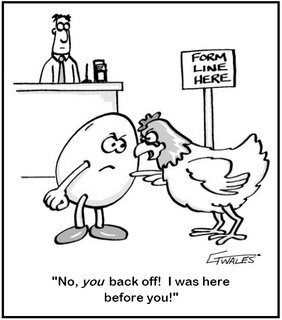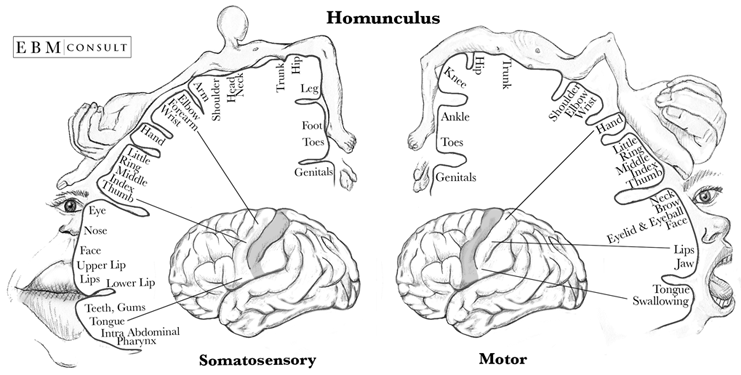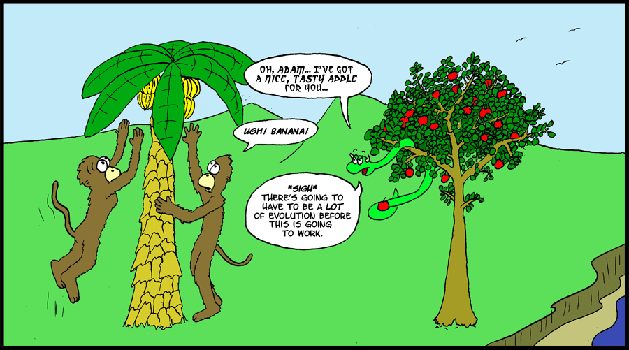Reason and Emotion: The Children of Desire - Part V
Here's Part V of my essay about Reason and Emotion - how they differ, and how they are related. If you're just arriving, I encourage you to read the earlier parts where I go through the history and definitions of some of the key concepts: Part I | Part II | Part III | Part IV

Source


I will now return to our discussion about the nature of emotion and reason. As we examine the evolutionary chain of life, we will notice that the higher we go, the more complexity we find; and the more complexity we find in an organism, the more awareness of its surroundings and the closer we come to human consciousness.
As an example, a tree grows in the forest. If it is a small tree competing for light against many big trees, it will send out its roots and shoots of leaves but it will ultimately die without reproducing itself. If placed in a poor environment, the sapling will not survive because it can only perform its function by rote and by the genetic book. It does not move, and its capacity for adaptation is limited.
The life of an animal is more complex than that of a plant. Even the simple, one-celled amoeba makes its living in a more dynamic way. It shifts its shape by sending out tiny pseudopods out of its body ever looking for the next tasty alga or bacterium. When it is ready to reproduce, the amoeba simply splits itself in two and goes on eating. Here we have an organism that can move around. It can change to a new environment and seek a better circumstance. But it is still limited in its ability to adapt to a changing world. Its movements come only from static, genetic commands.

Source
Our beloved dog is even more complex than an amoeba. Here we find the first signs of emotion in his wagging tail (not feeling, necessarily, but emotion-proper). When he tucks that tail between his legs and runs to the other side of the yard whimpering, this expression of fear tells you that there's probably some big beastie hiding in one of the bushes. But not only does this emotive behavior advertise potential threats and rewards to other animals in the dog's immediate area – the emotion of fear sends the dog running away. The emotion protects the dog from a threat; it is a more efficient tool of adaptation than the amoeba's lackadaisical life of floating, consuming, and splitting.

Source
Without the omniscience of God, or access to a time machine, we will never know precisely how or why emotion first came about. We can be sure, however, that, like all evolutionary traits and processes, emotion developed incrementally and over a large span of time. (It continues to develop as you read this paper.) First off, for emotion to have any beneficial effect, an organism must have a way of perceiving the world at a distance. The amoeba slip-sliding through life has no means of perception except through its cellular wall. It can have no awareness of anything in the world other than that which it touches. To be struck by fear at the instance of touching a predator will not help the doomed amoeba. By the time it has reached that proximity, the amoeba can neither run nor hide. It can only be eaten. The development of emotion can only help that organism with senses like sight and sound and smell. Emotion only makes sense for the animal who can perceive danger or benefit from a distance, and the greater that distance, the more time it has to react and adapt to the new situation.
The same goes for stationary organisms. The mighty oak does not fear the approach of the logger wielding the sharp, hefty ax. For one, the tree has no means of perceiving the logger until the ax blade is dug five inches into its trunk. But just as important, the tree has no means of escape. Even if it could sense the approaching danger, the oak cannot lift its roots from the earth and scurry in flight deeper into the forest. The feeling of emotion bestows no benefit on any organism that cannot move and that cannot perceive the world at a distance. And if it does not bestow a benefit, there is no reason that such a trait should have developed at all.

Source
But what a boon it is for those dynamic animals who were able to develop powerful senses of sight and sound! The emotion of joy and contentment keeps them doing those activities that best suit them; and fear sends them running to some safer more joyful place. Anger helps them smite the “evils” in their world and protect those they cherish and value. Yet still we are only speaking of emotions-proper. We know of only one organism, Homo sapiens, who experiences that other more subjective half of emotion, feelings.

As I stated earlier, feelings are the conscious experience of emotive states. These emotive states are perceived by our consciousness by reading body-maps located in specific regions in the brain. But this poses a problem: It suggests that consciousness existed previous to feelings, and this would seem to contradict any assumptions we hold about consciousness. For if, as I argued before, the development of emotion-proper would have been useless without any means to implement it, like movement and perception at a distance, the same should be true about consciousness. Consciousness could not have developed if there was not first some sort of feeling process to guide its actions.

Source
Antonio Damasio understands this paradoxical “which came first?” problem and explains:
The relation between feeling and consciousness is tricky. In plain terms, we are not able to feel if we are not conscious. But it so happens that the machinery of feeling is itself a contributor to the processes of consciousness, namely to the creation of the self, without which nothing can be known.
Damasio goes on to say that this underlying machinery of body-maps must have existed previously to the development of both feeling and consciousness (consciousness as awareness of self). These body-maps in the brain developed as part of the organism's emotive infrastructure. In order for the brain to send out its commands to wag the dog's tail in joy, or increase the dog's heartbeat at the approach of a stranger, the brain must first have had a way of determining the rest of its body's state which called for that specific order. Thus, body-maps in the brain developed.

Source
Once that machinery was already in place, the parallel developments of feelings and consciousness were able to usurp its use. Evolution allowed for the manipulation of function of a biological fact already in existence. Body-maps were now used to help define that basic boundary of consciousness – that between Self and Other. And they promoted the development of this self as a consciousness that now could perceive what used to be exterior, physiological responses to the outside world, as interior emotive states laden with judgments of value.
Values are the hallmark of life. As I stated earlier, a value is simply some thing or action that an organism seeks to gain or keep or do. Even the amoeba swimming through a river of darkness is acting to achieve something: its values are eating, excreting, and reproducing. But the amoeba has no awareness of these processes nor of its own striving for value.
The development of emotion-proper is the first step toward achieving such an awareness. Those organisms that have access to emotion-proper are born with an inherent sense of “good” and “evil”. The good is that which promotes and betters its life, and the evil is that which detracts from or destroys that life. The physiological responses of fear and anger and joy propel such an organism toward value and away from danger, at least as far as its biologically inherited instinct can guide it.

Source
The appearance of feelings is only a more efficient means to the same end. While philosophers have described feelings as crippling and enslaving, this is only because they did not have access to an evolutionary perspective. When compared to organisms with only emotions-proper, we find that feelings bestow a greater amount of freedom and control. While the emotions-proper are basically static responses to exterior events, feelings are knowable and more dynamic.
Human beings are born with the same inherent sense of “good” and “evil” as the rest of the animal kingdom. This is not a knowledge of what objects or actions are good and evil for a man, but only a knowledge of what it means to live in a state of “goodness” or “badness”. The fact that one feels “good” or happy is a signal from the body saying, “Hey, whatever you're doing, keep it up!” At the same time, the feelings of sorrow and shame are saying, “Time to make a change! Remember the last time you felt joy? Go back to that!” Feelings allow people to learn and adapt to a changing world. They are super calculators that inform the brain of the rest of its body's state, as well as the body's relationship to the value-laden objects contained in its environment. The consciousness of value arises only from the existence of feelings.

Okay - that's it for Part V. We've almost reached the conclusion! You can find Part VI HERE.
If you found this post interesting and/or useful, I certainly appreciate all upvotes and follows. And I'd love to continue the conversation in the comments below. Thanks for reading
References
- Damasio, Antonio. (2003). Looking for Spinoza: Joy, Sorrow, and the Feeling Brain. New York: Harcourt, Inc.

We must control our emotion to have reason... :D
Well, in the next part I'll be going into more detail about reason. But my main thesis is that both emotions and reason are tools that have evolved to achieve the same end: gain value. Both of these tools are finite and flawed, and sometimes they do conflict. But ultimately reason is not possible without emotion, because it is emotion that attaches value to the things we reason about.
Very true and great point. Emotions does move us and add value. Excellent insight @jpgaltmiller!
Now thinking more about it...when you do control your emotions and mind, I think you can have reason or motivation without emotion. Just intellectually know why you believe in something...?
Look, I was raised by a mother who was uber-emotional, and I think my reaction to that was to clamp down on emotion, control it as you say. So I definitely hear where you're coming from.
At the end of the day, though, you can't control your emotions. All you can do is control your behavior that results from your emotions. You can also examine your emotions, see what triggers what, and decide whether or not that emotional response is beneficial for you or not. And with that examination, you can, over time, affect your future emotional responses, perhaps. But that is not the same thing as controlling one's emotions in the moment. Your emotions are lightning-quick calculations of value judgment in reaction to the stimuli you perceive.
Stick with me for the next two posts on the subject - things might become a bit clearer.
Ya I think that is more of what I was thinking... controlling your behaviours to emotions. After meditating for the last couple years I definitely know how to control triggered emotions more and how I react to them. I was not in control of them at all like many people are, as I am now.
Will look forward to your next posts anout it though. Appreciate your response here.
That is something I haven't tried - meditation. But the more I listen to Sam Harris' podcast, the more I think it can be beneficial.
It is massively beneficial
Such an interesting and thought provoking post
Emotions control so many decisions that we make, but I think emotions are good and help make us who we are, but they need to be balanced also with needs and logic to help us to choose the best path
Thanks for reading! I'd say emotions are tools that help us reach certain goals, but they are inefficient or unsuited for other goals. Reason is a sharper tool, though it too is finite and fallible. But I'll go into more on that in the next post.
Good d points
This post has received an upvote from spotlight thanks to: @resteemable.
Your Post Has Been Featured on @Resteemable!
Feature any Steemit post using resteemit.com!
How It Works:
1. Take Any Steemit URL
2. Erase
https://3. Type
reGet Featured Instantly � Featured Posts are voted every 2.4hrs
Join the Curation Team Here | Vote Resteemable for Witness
This post has received a 0.57 % upvote from @drotto thanks to: @peppermint24.
nice post!
Congratulations! This post has been upvoted from the communal account, @minnowsupport, by jpgaltmiller from the Minnow Support Project. It's a witness project run by aggroed, ausbitbank, teamsteem, theprophet0, someguy123, neoxian, followbtcnews, and netuoso. The goal is to help Steemit grow by supporting Minnows. Please find us at the Peace, Abundance, and Liberty Network (PALnet) Discord Channel. It's a completely public and open space to all members of the Steemit community who voluntarily choose to be there.
If you would like to delegate to the Minnow Support Project you can do so by clicking on the following links: 50SP, 100SP, 250SP, 500SP, 1000SP, 5000SP.
Be sure to leave at least 50SP undelegated on your account.
Postingan yang sangat bagus, saya menyukai postingan anda @jpgaltmiller
It's a good thing Google is fluent in Indonesian: "Very nice post, I liked your post." Thanks for reading.
Congratulations! This post has been chosen as one of the daily Whistle Stops for The STEEM Engine!
You can see your post's place along the track here: The Daily Whistle Stops, Issue # 52 (2/21/18)
The STEEM Engine is an initiative dedicated to promoting meaningful engagement across Steemit. Find out more about us and join us today!